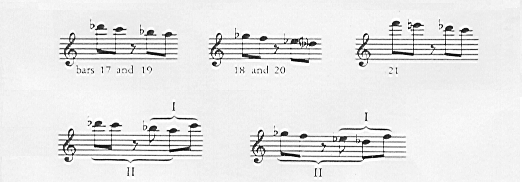derived from the original thought of the Grave, to which merely one new phrase
(motif II) is added.
Example 10: Outline
of bars 17-21 of the first subject of the first movement and
their relation to Motif
I of the Grave

Example 11: Bass
accompaniment of the first subject (bars 9-23) of the first
Movement showing its
relation to motifs I and II

Like Leichtentritt, Réti notes the link between the first
and second subject of the first movement. He observes that the beginning of the
second subject is actually a "...greatly slackened reiteration of the nervous,
agitated first theme,"
as shown in Example 12. He also illustrates that the connection of the second
subject to the work as a whole is not confined to is first three notes. Example
13 shows that the varied repetition of this subject (beginning in bar 57) can
be seen as a derivative of the